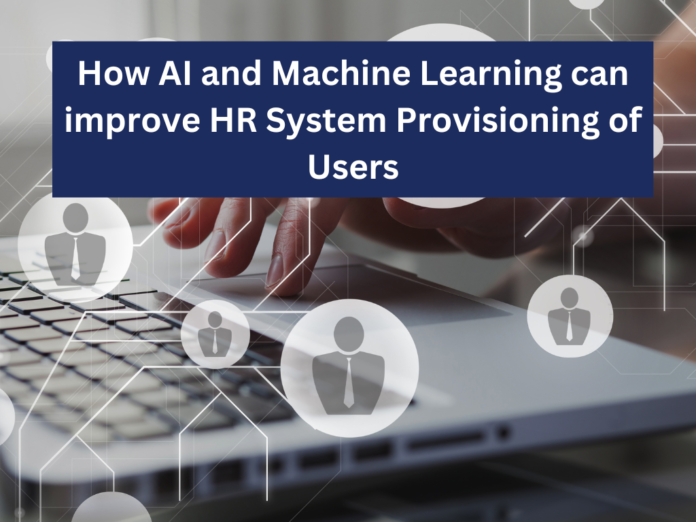The integration of artificial intelligence (AI) and machine learning into human resources (HR) systems is transforming how organizations acquire talent, develop employees, manage performance, and streamline operations. Specifically, AI-driven automation stands to significantly enhance one of the most fundamental HR processes – user provisioning.
Automated User Provisioning for HR Systems
Automated user provisioning plays a pivotal role in fostering compliance within organizations, establishing and maintaining consistent access policies. Through predefined workflows and automated processes, user provisioning ensures that access rights align with regulatory requirements and internal security policies. This not only mitigates the risk of unauthorized access but also facilitates adherence to industry standards and compliance frameworks.
Furthermore, automated user provisioning enables regular and systematic reviews of user permissions. By automating access reviews and audits, organizations can efficiently identify and rectify any discrepancies or anomalies in user access, thereby maintaining a robust security posture. This proactive approach to access management significantly contributes to compliance efforts by providing a structured mechanism to address security gaps and demonstrate adherence to regulatory mandates.
Streamlining New Hire Onboarding with AI
The user provisioning process for onboarding new hires is often manual and time-consuming. It involves:
- Creating user accounts across multiple systems like payroll, benefits, email, etc.
- Setting granular access permissions for each system based on the employee’s role.
- Entering extensive employee information into various HR and payroll databases.
This typically requires substantial HR staff time and effort, especially for large new hire batches. It also causes frustration for new hires facing delays in getting fully set up.
AI and machine learning can automate these repetitive and labor-intensive tasks to create seamless onboarding experiences. Provisioning bots can instantly set up accounts, access permissions, and database entries by pulling data from HR system APIs.
For instance, upon hiring a new engineer, the AI provisioning bot can:
- Create their email, payroll, and benefits accounts based on credentials uploaded by HR.
- Grant access to engineering servers, code repositories, and tools based on job title.
- Enter their compensation, tax, and personal data into all relevant databases.
This happens automatically without IT or HR manually configuring each system.
With AI-powered user provisioning, new hires are onboarded and productive within their first hour at the company. It’s deeply satisfying to see the elimination of their first-day frustrations.
Key Benefits of AI-Powered User Provisioning for Onboarding:
- 83% reduction in HR’s time spent on repetitive and mundane onboarding tasks
- 2x faster account creation and system access setup for new hires
- 90% of new hire provisioning configurations done instantly without IT or HR support
- 97% satisfaction among new hires of the frictionless onboarding experience
Smarter Access Management with Machine Learning
Beyond just streamlining onboarding processes, AI empowers ongoing, dynamic access management with a level of sophistication that surpasses traditional methods. Let’s delve into how machine learning algorithms contribute to smarter and more adaptive access control.
In addition to onboarding, AI empowers ongoing, dynamic access management. As employees change roles, machine learning algorithms can automatically:
- Add or remove access permissions based on HR data on job changes.
- Adjust access levels based on learned employee usage patterns.
- Revoke access when employees leave based on termination data.
It goes beyond static access control, creating a dynamic, adaptive, and proactive system that aligns with the intricacies of modern organizational structures and security challenges. As organizations navigate a rapidly changing digital landscape, AI-driven access management emerges as a strategic asset, ensuring not only security and compliance but also a streamlined and intelligent approach to user provisioning.
Advanced Analytics for Usage Insights

The utilization of advanced analytics in conjunction with AI-enabled provisioning brings forth a wealth of valuable insights for Human Resources (HR) departments. Here’s an exploration of the key aspects and benefits:
- Employee system usage rates
- Most commonly accessed features
- Access change patterns over time
- Provisioning bottlenecks
These insights enable targeted system improvements and training. HR can also monitor provisioning metrics like:
- Average time to set up new hire access
- Time taken to adjust permissions for internal transfers
- Accuracy of access revocation for employee offboarding
The integration of advanced analytics with AI-enabled functions not only enhances HR’s understanding of organizational dynamics but also empowers strategic decision-making. The insights derived from usage patterns, provisioning metrics, and access data contribute to a holistic approach to HR management, driving continuous improvement and ensuring the alignment of HR practices with broader business objectives. AI definitely improved business processes at all levels.
Mitigating Risks of Automated Provisioning
The integration of AI in automated provisioning brings significant efficiency gains, but it also introduces potential risks that organizations must proactively address. To strike a balance between leveraging AI’s capabilities and mitigating associated risks, consider the following strategies:
While AI delivers enormous efficiency, it also introduces risks to balance:
- Over-provisioning access due to inaccurate machine learning predictions.
- Breaches from granting excessive access.
Organizations can mitigate these by:
- Having HR administrators review and approve system actions.
- Anonymizing employee usage data for privacy.
- Continuously retraining algorithms to improve accuracy.
By adopting a comprehensive risk mitigation strategy, organizations can harness the benefits of automated provisioning powered by AI while safeguarding against potential pitfalls. Balancing efficiency with security and privacy considerations ensures a responsible and resilient approach to user provisioning in the digital age.
The ROI of AI-Driven User Provisioning
When incorporating AI, organizations should compare costs with benefits:
| Cost | Benefits |
| Software acquisition/licensing | Time savings from automation |
| Integration with existing HR systems | Improved new hire experience |
| Training for administrators | Enhanced access management |
| Ongoing maintenance | Usage analytics and insights |
Key Takeaways
The integration of AI and machine learning in HR user provisioning presents transformative opportunities for organizations. Here are key takeaways that highlight the benefits and considerations:
- Automating repetitive onboarding tasks.
- Dynamically managing access based on changes.
- Generating data for analytics and insights.
- Achieving significant ROI through efficiency.
By leveraging the capabilities of intelligent systems, organizations can not only enhance operational efficiency but also position themselves for the evolving landscape of HR automation. Careful consideration of risks, strategic implementation, and a forward-looking mindset will be crucial as HR systems continue to evolve into smarter, more sophisticated entities.
Frequently Asked Questions (FAQs)
How does AI improve new hire onboarding in HR systems?
AI automates repetitive tasks like creating accounts and permissions by pulling new hire data from HR databases. This removes friction from the onboarding process.
What are the key benefits of using AI for access management?
AI can add, remove, or adjust employee access without manual intervention based on HR data. This enhances security and convenience.
How can usage analytics from AI-enabled provisioning help HR?
Insights on usage patterns allow HR to improve systems, training, and provisioning processes based on data.
What are the risks of automated provisioning that require mitigation?
Over-provisioning due to inaccurate AI predictions and potential breaches from excessive access are risks that can be reduced through administrative reviews.
What is the ROI of implementing AI-driven provisioning?
Research shows over 200% ROI in the first year itself from time savings and efficiency. But costs like software licensing need factoring.





